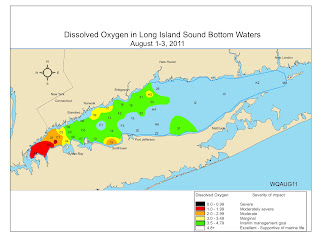Progress on the Sound
That hasn’t quite happened. My reading of the data collected by the Connecticut Department of Energy and Environmental Protection is that there has been some improvement but it’s not dramatic. Yet.

But if you believe that the people overseeing the cleanup are right that removing nitrogen from treated sewage will eventually lead to better water quality, then you have to also believe that things are going well, because the progress in nitrogen removal, in my opinion, has been good.
I’m basing this judgment on numbers I saw in the most recent biennial report of the Long Island Sound Study, which was released last week.
Remember that the original goal, set, if I remember correctly, in 1998, was to remove 58.5 percent of all the nitrogen that enters the Sound from sewage plants, by 2014 (that deadline has been changed to 2017 because of engineering problems in New York City and Westchester that have to do, as I understand it, with the size of the plants [NYC] and the fact that there is little room to expand the plants [Westchester]).
The biennial report says that we are 70 percent of the way to the 58.5 percent goal, an improvement of 18 percentage points since 2009. Here’s a quote from the report:
Since the early 1990s, when baseline discharges were calculated at 59,147 pounds per day, a total of 25,444 equalized pounds per day have been reduced. The ultimate goal is to reduce point source nitrogen inputs to Long Island Sound by another 11,000 pounds. In 2010, the states reached 70% of the final reduction target compared to 52% in 2009.
And this:
Ten plants, 8 in CT and 2 in NY, completed final or phased upgrades in 2009 and 2010 at a cost of $339.83 million. … About 60% of the reduction was the result of an interim project completed at the Hunts Point plant in the Bronx.
And this...
In 2010, The Wards Island Plant plant in New York City reduced 3,006 equalized pounds per day from baseline years as part of a demonstration project that involved the use of methanol. The innovative method, available for large plants, is called the SHARON (Single Reactor System for High Ammonia Removal Over Nitrate) process.
The progress at Wards Island and Hunts Point is encouraging because those treatment plants and two others in the Bronx and Queens -- Tallmans Island and Bowery Bay -- are huge: they are responsible for about 700 million of the 1 billion gallons of treated sewage discharged into the Sound every day.
If New York City is succeeding in removing nitrogen, that is likely to be very good news for Long Island Sound.
Labels: hypoxia, Long Island Sound Study



0 Comments:
Post a Comment
<< Home